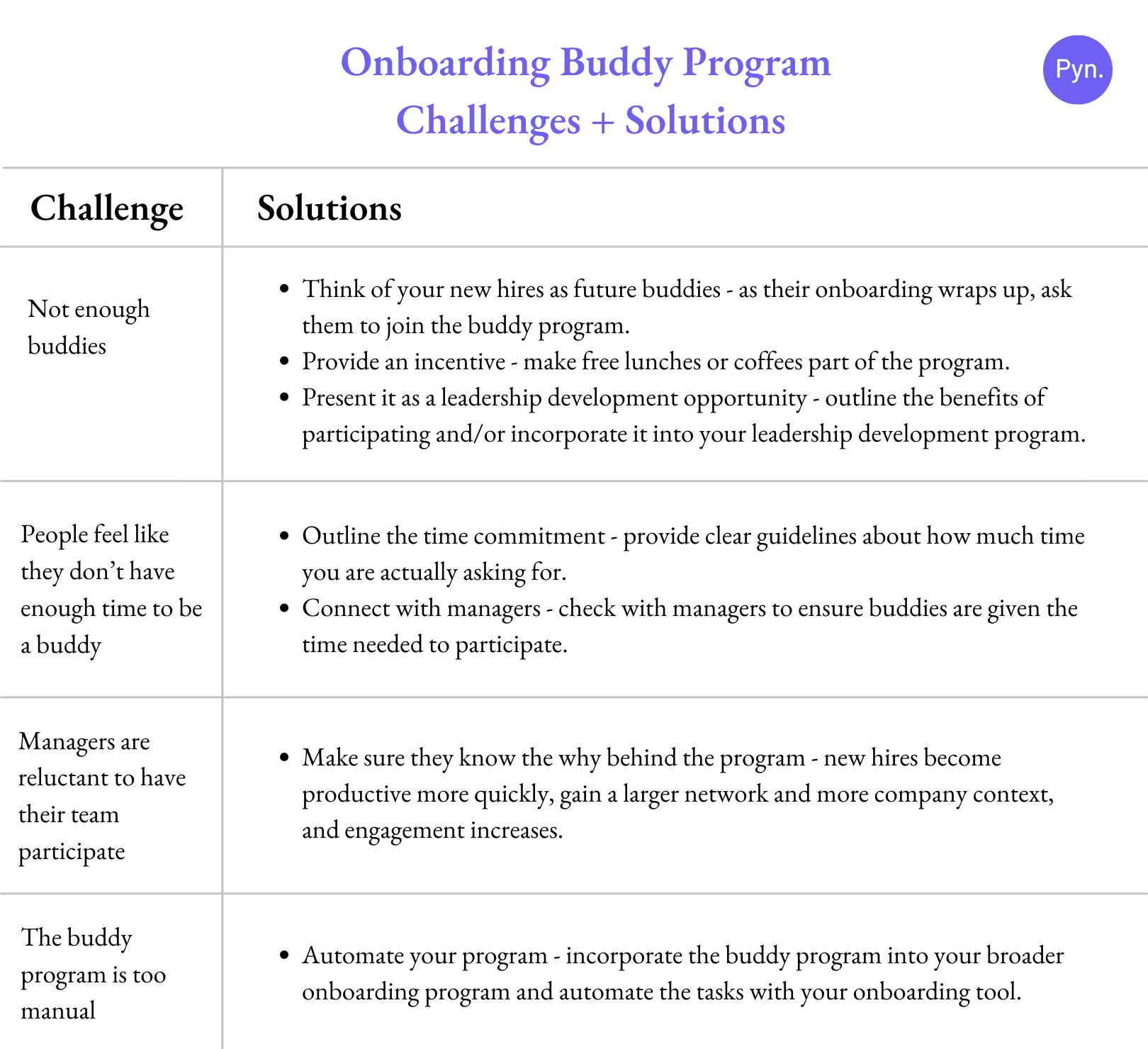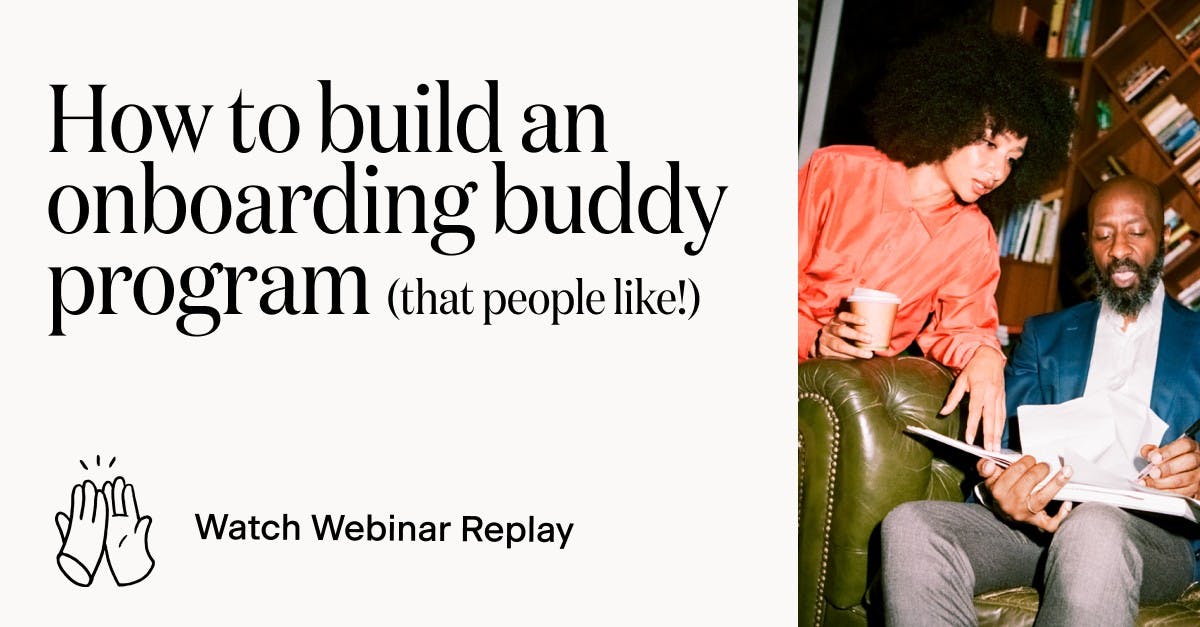How to build an onboarding buddy program
There are many things are on a new hire’s mind leading up to and during their first weeks at a new job. They’re thinking about paperwork, how they’ll meet new people, making a good impression on their manager and team, or if they’ll be dropped into a big project right away. With more new hires starting remotely these questions can loom even larger.
When HR teams first think about creating an onboarding buddy program, they often focus on these things. While there are many benefits to the new hire, like an increased sense of social connectedness and reduced anxiety about entering a new environment, what an onboarding buddy program brings to your organization extends far beyond that.
In this article, we cover the benefits of an onboarding buddy program, define what a buddy is (and is not) and give you four steps to creating the best onboarding buddy program you can create!
The benefits of an onboarding buddy program go beyond the new hire
Having a buddy helps new hires navigate an organization’s unspoken cultural norms, build up their networks, and get deeper context about the organization - all of which leads to them feeling more engaged, confident and productive.
For the onboarding buddy, participating in the program means an opportunity to build a larger network within the organization, develop leadership skills, and deepen their own understanding of the organization by teaching someone else about it.
For the organization, maintaining a buddy program leads to increased employee engagement and sense of belonging, increased retention, and better ramp-up times for new hires. In research done at Microsoft (source), 73% of new hires who met with their buddies at least twice in their first 90 days believed their buddies helped them to quickly ramp up in their role. Meeting at least four times increased that number to 86%. Their research also found that having a buddy led to a 36% increase in satisfaction with their onboarding experience. The impact of this reduced time to productivity and increased satisfaction over an entire company is massive.
This is especially important as organizations move more toward hybrid and remote work. Creating intentional opportunities for new hires to build their networks and connect with their coworkers will reap broader benefits. In research conducted by Gallup, employees who have a best friend at work “are seven times as likely to be engaged in their jobs, are better at engaging customers, produce higher quality work, have higher well-being, and are less likely to get injured on the job.” (source)
An onboarding buddy program is one way to help new hires develop those friendships.
What’s in a name? The buddy, defined
As you develop your onboarding buddy program, you should begin by outlining what a buddy is and what makes for a good buddy. An onboarding buddy is someone who helps acclimate the new hire to the organization and points them in the right direction when they have questions.
Keep in mind that not everyone is buddy material. Ideally, managers should be responsible for selecting the buddy so they can choose someone who has context about the new hire’s role. You can help your managers select well-suited buddies by providing them guidelines for who would make a good buddy. Generally, when choosing a buddy, you want someone who:
- Is a strong performer
- Lives the organization’s values
- Wants to be a buddy
- Can be given the time needed to carry out the buddy responsibilities
- Has knowledge of the new hire’s role
Four steps to creating a successful onboarding buddy program
After you’ve defined what a buddy is, there are four steps you should take to create your program:
- Outline buddy responsibilities
- Get a ahead of the challenges
- Automate the program
- Evaluate the program
1. Outline the buddy’s responsibilities
A large part of creating a successful program is ensuring that the expectations and responsibilities are clear. An onboarding buddy should know the time commitment they are making, the resources available to them, and what they are expected to do.
Onboarding buddy programs vary quite a bit in terms of length of program and overall time commitment. In creating a program, you have to be mindful of what works best at your organization. At Pyn, we recommend that buddies support new hires for their first two months. This includes:
- First day introductions and office tour (as applicable)
- First week lunch (in-person or virtually)
- Weekly check-ins (~15 minutes) throughout the first two months
- Month two lunch or coffee (in-person or virtually)
Including time spent on responding to ad-hoc questions, the overall commitment for a buddy for this program is about 6-10 hours.
Another factor that can vary in onboarding buddy programs are the financial resources available. In outlining your program, be clear whether lunch or coffee will be provided for or reimbursed by the company. In order to create a more inclusive program, it’s best not to assume that the buddy or the new hire have the financial resources to participate. If you can remove that factor by providing money for lunch or coffee, you can make the program more accessible.
Lastly, you want to be clear about what the buddy’s responsibilities are. Remove any awkwardness about what the buddy needs to do by providing guidelines. The guidelines don’t need to be overly rigid, but should provide an understanding about the goals for the relationship.
The guidelines we recommend are:
- Respect the new hire’s confidentiality. The new hire should feel comfortable asking questions knowing that the buddy will not be reporting back to someone or talking to other team members about what was asked.
- Build (don’t force) rapport. Before the new hire starts, it can reduce anxiety for them if the buddy reaches out by email or on LinkedIn to introduce themselves. Or, on the first day, buddies can introduce themselves, provide contact information, and context about their role. They should let the new hire know about their communication preferences, invite them to lunch and pertinent work events, and help them get acclimated. But, they don’t need to force a friendship. Let the relationship develop in a way that suits the new hire. Maybe it is a relationship that extends beyond onboarding, and maybe it isn’t. That’s ok!
- Make yourself available (within reason). A buddy’s role is to answer general, day-to-day questions, direct the new hire to resources, and provide context about the company’s culture. A buddy doesn’t need to be on-call or know the answer to every question. The buddy should feel comfortable setting boundaries and directing a new hire’s questions elsewhere, as appropriate.
- Be a connector. Especially in a hybrid and remote work environment, it can be challenging to meet other people and get context about the company. The buddy’s role should include helping the new hire build their network. This can mean providing connections to ERGs, chat channels for hobbies, or introductions to colleagues throughout the organization.
Get Pyn's Onboarding Buddy Program Overview
Includes buddy responsibilities, guidelines, is/is not table, and program feedback
2. Get ahead of the challenges
There are a few common challenges that administrators of onboarding buddy programs run across. In designing your program, thinking about these challenges at the beginning can help you head them off.

3. Automate your buddy program
At this point, it’s time to weave your buddy program into your overall onboarding program. If you don’t currently have an onboarding program or tool, you can use our comprehensive employee onboarding checklist to get started.
Using a tool to automate your onboarding program, like Lucid has done by using Pyn, will save you time, eliminate many manual tasks, and provide a consistent new hire experience. Look for a tool that allows you to easily update your employee data, provides template onboarding content, and sends accessible and timely communications to your employees. Ideally, your tool will also include buddy selection capabilities.
Within Pyn you have the ability to do things like:
- Send a Slack or email message to a new hire’s manager allowing them to select a buddy directly
- Set up automatic reminders if a buddy hasn’t been selected
- Easily see if someone has recently been selected as a buddy
- Create a personalized message to the buddy from within Slack
- Automatically send messages to the onboarding buddy with details about the buddy program

4. Evaluate with our buddy program survey questions
Lastly, build in your feedback loop. Check in personally or through a survey with both the new hire and buddy at the end of the two months. You can use our buddy program survey questions to ask about:
- Their general satisfaction with the program
- If they recommend the buddy program
- If they found the buddy program effective
- How they benefited from the program
- If the new hire understands how their role contributes to their team and to the company’s mission
- If the new hire knows who to consult or where to find resources if they have questions
- If the new hire has been able to build up their internal network
This will help you iterate on the program and provide valuable information you can share with your team and the company about the success of the program.
We've created two templates with buddy program survey questions you can use as inspiration for you program evaluation:

